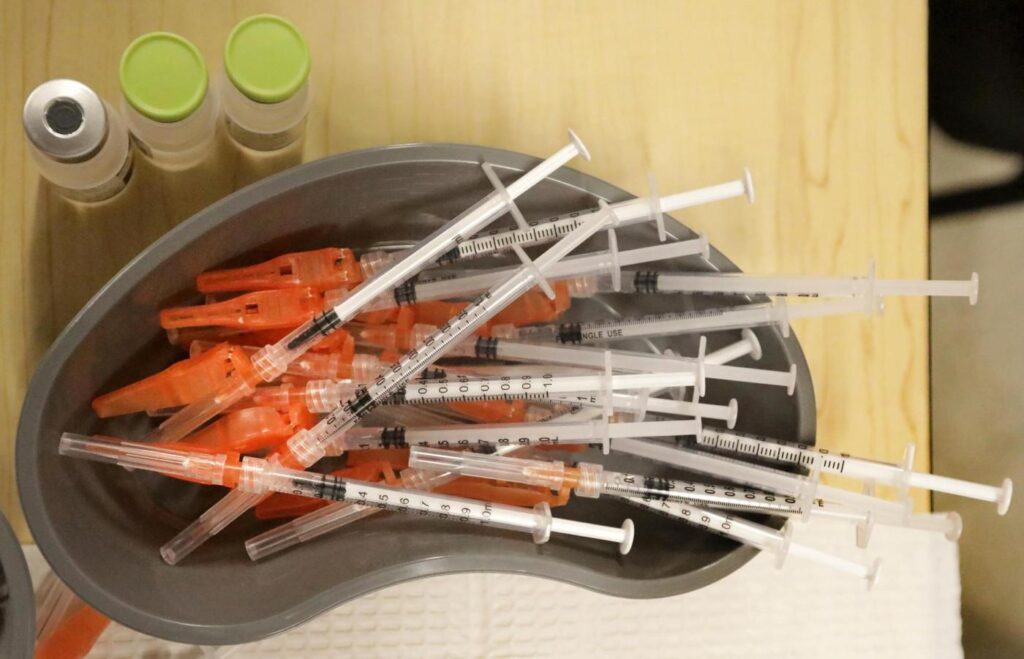
By MATTHEW PERRONE
WASHINGTON (AP) — While many Americans are trying to move on with their lives after two years of the COVID-19 pandemic, U.S. health officials are debating the best way to use vaccines to stay ahead of the coronavirus.
A panel of U.S. vaccine experts was meeting Wednesday to discuss key questions for future COVID-19 booster campaigns. The Food and Drug Administration’s vaccine advisers won’t make any binding decisions, but they could help shape the government’s approach for years to come.
FDA vaccine chief Dr. Peter Marks told reporters last week that it wouldn’t be surprising if the agency authorized another booster dose in the fall to protect most Americans against the latest coronavirus mutations. He opened Wednesday’s meeting by cautioning that waning vaccine protection, new variants and colder weather later this year could raise the risk of more surges.
“All that taken together makes us conclude that a general discussion of booster vaccination against COVID-19 is warranted at this time so that we can potentially intervene,” Marks said.
Some of the key questions for the panel:
HOW SHOULD THE U.S. DECIDE WHEN TO LAUNCH FUTURE ROUNDS OF BOOSTER SHOTS? WHO SHOULD GET THEM?
The panel heard presentations from government health officials and independent researchers that underscored the challenges of predicting what the virus will do.
Trevor Bedford, a disease modeler with the Fred Hutchinson Cancer Research Center, said a major new strain like omicron could emerge anywhere from every 1.5 years to once a decade, based on currently available data. Given that unpredictability, researchers will need methods to quickly determine whether current vaccines work against emerging variants.
Last week, the FDA authorized an extra Pfizer or Moderna shot for anyone 50 or older and for some younger people with severely weakened immune systems. It’s an effort to get ahead of another possible surge.
Only about half of Americans eligible for a third shot have gotten one. And some independent experts disagree about the need for even that additional protection in healthy individuals, due to limited evidence of the benefit or how long it might last.
The FDA has based many booster decisions on data from the Israeli government, which began offering a fourth dose to people 60 and older in January.
Early data on that effort published this week showed that the fourth dose significantly lowered rates of severe disease. But protection against any infection faded fast, with little evidence of a benefit for people who received a fourth dose after several weeks.
The last U.S. wave was driven by the omicron variant. During that surge, two vaccine doses were nearly 80% effective against needing a breathing machine or death — and a booster pushed that protection to 94%, federal scientists have reported.
COVID-19 cases have dropped to low levels in the U.S., but health officials are warily watching an omicron sibling that now accounts for most cases.
WHAT’S THE PROCESS FOR UPDATING VACCINES TO ADDRESS NEW VARIANTS?
All the COVID-19 vaccines now used in the U.S. are based on the original coronavirus version that emerged in late 2019. Updating the vaccines will be a complex task, requiring coordination between the FDA, manufacturers and global health authorities.
In response to panel questions, a representative for the U.S. Biomedical Advanced Research and Development Authority laid out the narrow window that manufacturers would face to reformulate, study and mass produce an updated vaccine by September.
“If you’re not on your way to a clinical trial by the beginning of May I think it’s going to be very difficult to have enough product across manufacturers to meet demand,” said Robert Johnson, deputy assistant secretary of BARDA.
The timeline for updating annual flu vaccines offers one possible model, and the FDA panel was expected to discuss the strengths and weakness of adopting such an approach.
Twice a year, World Health Organization experts recommend updates to flu vaccines to target emerging strains. The FDA then brings those recommendations to its own vaccine panel, which votes on whether they make sense for the U.S., setting the stage for manufacturers to tweak their shots and begin mass production.
But COVID-19 hasn’t yet fallen into a predictable pattern like the flu. And vaccine manufacturers will likely need more time to conduct additional studies of their COVID-19 vaccines, which don’t have the same decades-long record of safety and effectiveness as flu shots.
___
The Associated Press Health and Science Department receives support from the Howard Hughes Medical Institute’s Department of Science Education. The AP is solely responsible for all content.
